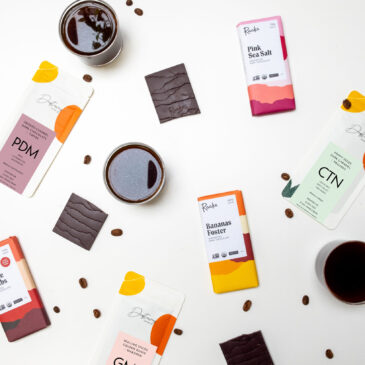Coffee and chocolate come from two very different plants that originated on entirely separate continents, yet they’re a natural pair.
They’re both adored for their complex flavors and the uplifting buzz they bring. The roasting process brings out many similar flavor notes in coffee and chocolate — words like nutty, fruity, floral, bitter, tobacco, or chocolatey get tossed around to describe both.
Delicious as they are on their own, when you put them together, they create combinations of flavors and aromas that complement each other wonderfully.
There are many ways to enjoy coffee with chocolate, whether it’s a dash of cocoa powder on your cappuccino, a classic mocha, a chocolate-covered coffee bean, a white chocolate mocha, or even just a square of dark chocolate alongside your espresso.
To help you sort through the options, we’ve put together a guide to which kinds of chocolate go best with which coffees and how. Keep reading for flavor magic!

Different Types of Chocolate
Chocolate comes from the seeds of the colorful football-shaped fruit pods that grow directly on the trunk of the cacao tree.
The fruit inside the pods is sweet, tropical, and gooey, but the seeds are terribly bitter and need to go through a multi-stage process to turn them into chocolate.
They’re fermented, dried, and roasted, then the shell is removed and the meat of the seeds — the cacao nibs — are ground down in a process called conching.
Then, they’re combined with sugar and other ingredients to create all the different types of chocolate we know and love.
There are many types of chocolate on the market, and you can experiment with just about every single variety when you pair it with coffee.

Driftaway Coffee Chocolate
Learn to taste chocolate and coffee the expert way! Custom coffee tasting kit and Raaka chocolates included.
Chocolate Varietals
Cacao is native to Central America – Mayans in the area that’s now Guatemala and Belize were the first to cultivate the tree and develop the process for making chocolate. Nowadays, it’s grown all around the world in tropical regions around the equator.
There are more than 10 different varieties of cacao trees, and farmers around the world are developing new hybrid varieties all the time. The main three varieties of cacao are Criollo, Forestero, and Trinitario.
Each variety has its own unique characteristics, with different colors, shapes, and flavors. Criollo is the finest of the three but is less productive and more expensive. Forastero is heartier but of poorer quality.
Trinitario is a cross between the two, which farmers developed when they feared Criollo might go extinct.
Single Origin Chocolate
Like with any crop, the genetics of the plant and the environmental conditions where it’s grown have a massive effect on its flavor.
Chocolate makers often blend different types of cacao to make sure their chocolate fits their brand’s specific flavor profile.
These days, you can find more and more chocolate makers releasing “single origin” chocolates, where the cacao they use to make the chocolate all comes from a specific country, region, or even a specific farm.
When you taste different single-origin chocolates, it becomes very clear how different climates, soils, farming practices, and processing techniques can affect the unique flavors of each chocolate.
Single-origin chocolate is often marketed as “bean-to-bar” chocolate. So, how does criollo cocoa from Ghana taste different from one grown in Colombia? What about two different types of cacao grown on the same farm?
Chocolate Products
After the beans from the cacao tree are dried and roasted, they’re ground down, which results in two products: cocoa butter — the smooth white fat from the nibs — and ground cocoa solids.
The differences between all those chocolate products you find in the stores all come down to the different ratios they use in combining cocoa butter and finely ground cocoa solids with sugar, milk powder, and other ingredients.
Here’s a quick rundown of the different chocolate products:
White Chocolate
White chocolate is chocolate with all the cocoa solids left out. It’s a very sweet, cream-colored product that’s made using sugar, cocoa butter, milk, vanilla, and lecithin (which helps hold the ingredients together in a stable blend).
It has a very creamy texture with a flavor like condensed milk and vanilla and can be used in decadent coffee drinks like a white chocolate mocha.
You can pair white chocolate with coffees that have bright fruit and floral notes. Costa Rican, Guatemalan, and Colombian coffees are good pairings for white chocolate.
More delicate coffees can be overpowered by strong chocolate flavors, so it’s best to pair them with lighter, sweeter chocolates like white chocolate.
Milk Chocolate
Milk chocolate is the most popular kind of chocolate in America. It has a soft, creamy texture, and a sweet, soothing flavor that tastes almost caramelized, without the bitterness of dark chocolate.
Milk chocolate is made with cocoa solids, cocoa butter, sugar, milk, and lecithin. The FDA definition of milk chocolate requires it to contain at least 10% cocoa and 12% milk.
Its sweet, mild flavor makes it easy to pair milk chocolate with all kinds of coffee. The creaminess of a piece of milk can balance out the bitter edge of robust dark roast coffees.
Or, if you have a sweet tooth, milk chocolate pairs exceptionally well with a milk-based coffee drink like a cappuccino.
Dark Chocolate
Unlike coffee, “dark” chocolate doesn’t refer to how it was roasted, but rather how much cocoa it contains.
Dark chocolate bars contain simple ingredients and can be made with nothing but cacao and sugar, but sometimes soy lecithin is used to help stabilize it.
Since there’s no milk and less sugar in dark chocolate, it has a firmer texture than milk chocolate, with a characteristic “snap” when a piece is broken off.
Dark chocolate is usually labeled with a percentage that tells you how much cocoa it contains. Most dark chocolate is in the 60%-72% cocoa range, generally containing a lower sugar content than milk chocolate.
The flavors of dark chocolate are unmasked by milk and are therefore more intense. Since dark chocolates have more robust flavors, they can pair well with stronger, dark roast coffees.
A square of dark chocolate alongside a shot of espresso is a simple and perfect pairing!
Cacao Nibs
Some chocolate producers sell roasted cacao nibs before they’ve been ground down to make chocolate. Cacao has a powerful, intense, and bitter chocolatey flavor.
Cacao nibs can be used in coffee drinks by grinding them and brewing them with your coffee grounds.
They work especially well in cold brew coffees, where they add depth to the flavor.
For a simple cacao cold brew recipe, grind the cacao nibs coarsely and add one gram of cacao for every three grams of coffee. After, let it steep in cold water as you would for a normal cold brew.
Cocoa Powder
Cocoa powder is made by separating the cocoa solids from the cocoa butter. The cocoa solids are crushed into a powder, which is great for baking and can be used as an ingredient in coffee drinks.
There are two types of cocoa powders: natural cocoa and Dutch-processed cocoa. Natural unsweetened cocoa powder is just pure cocoa solids and has a light brown color and powerful flavor that tastes chocolatey, bitter, and a bit acidic.
Dutch cocoa has gone through a process to neutralize some of the bitterness and acidity. Dutch cocoa has a deeper brown color and a mild flavor.
There are many ways to add cocoa powder to coffee to add depth of flavor. A great way to add it to a milk-based espresso drink is to sprinkle a bit of cocoa powder directly into the bottom of the cup before brewing the espresso over it and pouring the milk.
Different Types of Coffee
Coffee has come a long way since Kaldi noticed his goats buzzing with energy after eating the berries of a certain shrub on the Ethiopian plateau.
Nowadays, coffee is grown all around the globe in regions near the equator, and dozens of new varieties have been developed from the two main coffee varieties: Arabica and Robusta.

Driftaway Coffee Chocolate
Learn to taste chocolate and coffee the expert way! Custom coffee tasting kit and Raaka chocolates included.
Coffee Growing Regions
Where coffee is grown is one of the biggest factors that determines its flavor. Temperature, altitude, humidity, type of soil, and farming practices all affect the distinct flavor of each coffee tree’s fruit.
Low-grown Brazilian coffee will have a milder, sweeter, more earthy flavor than coffee from mountainous regions in Indonesia, which will taste more citrusy, nutty, and chocolatey.
Coffee from the highlands of Guatemala tastes spicy and floral, while coffee from the mountains of Ethiopia and Kenya has flavors like dried fruit and lemon.
Different Types of Coffee Roasts
Light Coffee Roast
A light roast means that the coffee beans were roasted to a lower temperature. They’re usually pulled out of the roaster when the beans reach a temperature between 355°F – 400°F.
In light roasts, the flavors of the bean’s origin are more prominent. In darker roasts, more of the flavors come from the roasting process itself.
Light roast beans have a light brown color and tend not to have as much oil on the surface. Light roasts tend to have bright, delicate flavor profiles with high acidity and floral and fruity notes.
Lightly roasted beans generally reach an internal temperature of 356°F – 401°F, right after the first crack occurs.
These beans tend not to be oily because they haven’t been roasted at a high enough temperature to draw the oils to the surface.
Light roast coffees pair well with creamy, sweet chocolates like milk chocolate or white chocolate.
Medium Coffee Roast
Medium roast coffees have less acidity and a more balanced flavor with more body than light roast coffees. Medium roast coffees also go by names like City Roast, Breakfast Roast, or American Roast.
Medium roasts are pulled from the roaster when the coffee beans reach about 410°F-430°F. Their flavors are more saturated than lighter roasts, while still maintaining a lot of the origin’s flavor notes. They’re often floral and fruity and feel almost juicy.
Medium roast coffee pairs well with light, sweet chocolates, and dark chocolates with under 70% cocoa.
Medium-Dark Coffee Roast
Medium-dark coffee roasts stay in the roaster until the coffee beans reach a temperature up to 435°F – 450°F.
The higher temperatures pull more of the oils to the surface of the beans, so you’ll notice medium-dark roast beans look more oily than lighter roasts.
The longer roasting time makes medium-dark roasts taste less acidic and slightly more bitter. They make for a rich cup of coffee, with a flavor profile that is spicy, chocolatey, smoked and has a caramel sensation.
Medium roasts are often called Vienna roasts or Full-City roasts. These coffees pair well with dark chocolate.

Driftaway Coffee Chocolate
Learn to taste chocolate and coffee the expert way! Custom coffee tasting kit and Raaka chocolates included.
Dark Roast
Dark roast coffee is roasted until the beans are well above 450°F. It takes an expert coffee roaster to make a dark roast that doesn’t taste burnt and bitter.
At those temperatures, all the moisture gets cooked out of the bean and it becomes very oily to the touch as all the oils from inside the beans liquify and leach to the surface.
Dark roasts have a rich and intense smoky flavor profile with a bitter finish and a lot of oil in the cup, giving it a full-bodied texture. Most of the delicate floral and fruity flavors from the origin have been cooked out of dark roasts.
Light and sweet chocolates like milk chocolates can pair well as a counter-balance to the bitterness of dark roast coffee.
The intense flavor of dark roast coffees will overpower most delicate chocolates, but high-percentage dark chocolate and a dark roast coffee make for a real power couple!
Happy Caffeinating!







